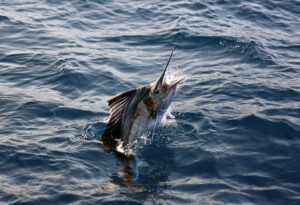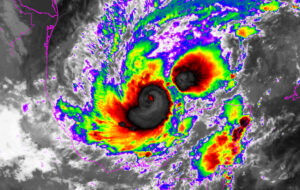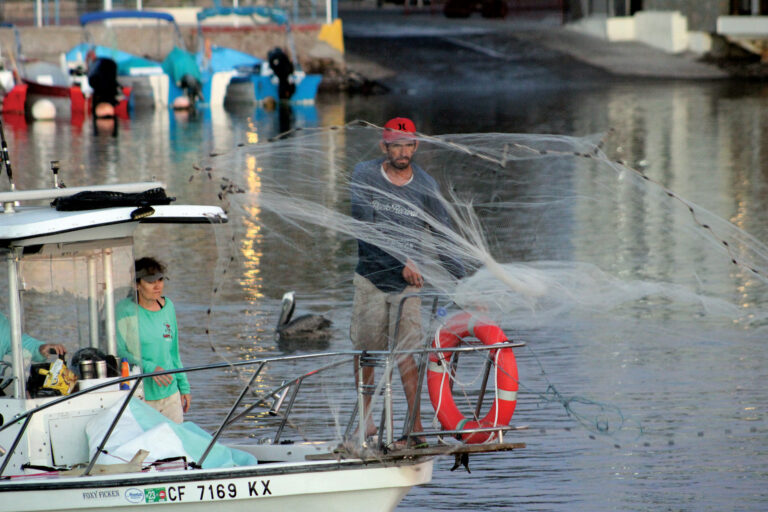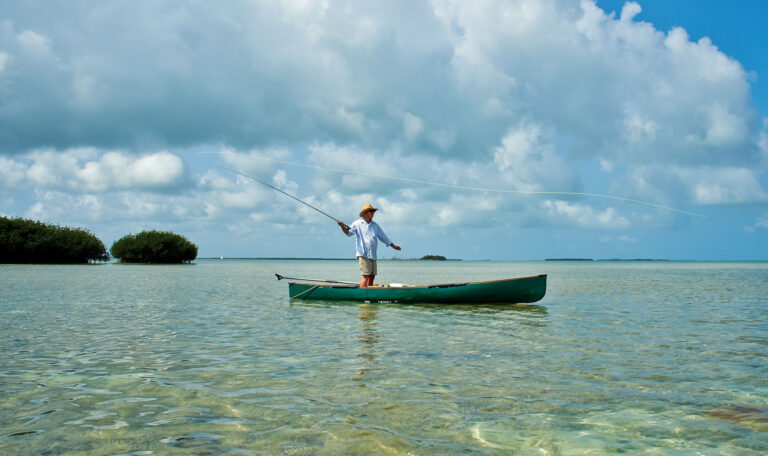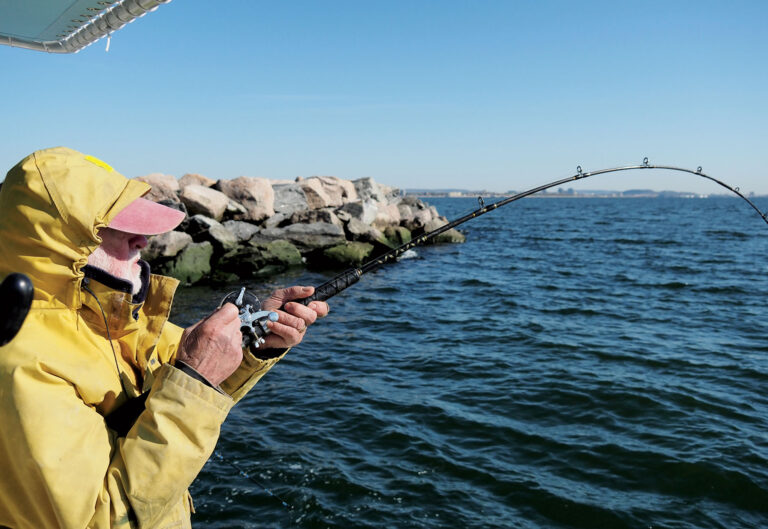Photos by Jim Leedom
Last fall, stripers pulled a no-show for the weeklong trip to Block Island, Rhode Island, my friends and I have been taking since the early 2000s. By day three, it became apparent that bass were not in their usual nighttime lies in any numbers (part of a troubling coastwide trend). So we faced two choices: cry in our beer, or pull on our big-boy waders and enter the scrum known as daytime surfcasting for bluefish.
We chose wisely.

Thirty-five years ago, when striper populations were crashing up and down the East Coast, blues rushed in to fill the breech. They saved the charter industry, which switched to trolling umbrella rigs and wire line for “gorilla blues.” Surfcasters adapted, too, though some scorned bluefish as “stinkfish” and “yellow-eyed devils” that destroyed lures and live baits with their powerful teeth or bit through their leaders. They kicked the fish back into the surf or sometimes threw them onto the beach, leaving them to rot. Even today, this stigma continues. But with striper numbers dropping, I suspect we may have to lean on these underrated and disrespected gamefish to once again save the day.
An ebbing tide hurries blue-green water over a long bar of cobble. Waves collide and recede, and golf-ball-sized rocks click and clack around our boots — sand in the making. Ten and 11-foot surf rods load and launch like trebuchets, sending pencil poppers, little necks and giant Docs seaward. We work the lures back to the beach, each angler fishing to his own cadence. Some reach high up the rod to make it rhythmically pulse back and forth; others stoically reel and pump, reel and pump.

A crater opens in the ocean, and something enormous takes a lure. A rod bends deeply, and the angler walks the hooked fish well away from the group to allow the others to continue casting. Then, in slow motion, a blockish head, mouth agape, followed by 14 pounds of blue-gray muscle tail-walks sloppily over the waves. A few of us cheer. Some root for the angler, others for the fish.
After what feels like a long time, a thick-shouldered, 35-inch bluefish slides onto the beach, still gnawing on the lure like a pitbull refusing to give up a hambone. Pliers are unholstered, the hook twists free, and the fish slides back into the Atlantic.

If bluefish have one fault, it is their overeagerness to destroy anything that moves. And while hooking fish on every cast may sound fun, it quickly devolves into the mundane. On this day, however, the blues remain delightfully selective, with a fish raised — and often missed — on every few casts. Each individual blow-up, each hooked fish, each head-shaking leap is a singular event seared into the brain.
I fight a very large blue for nearly 10 minutes. It crushed a Doc — a 9-inch surface walker that prompts napalm-like strikes. The fish has powered deep into the rip, where it tacks against a 3-knot current. When I finally coax it to the lip of the beach, I see it in the clear water — a yard’s worth of bluefish with a smaller fish ghosting behind. Just then, the lure yanks free. The smaller blue immediately grabs it, jumps and throws the Doc nearly at my feet. I chuckle, shake out a few hand cramps and fire out another cast.

My friend Rob’s beached fish lurches unexpectedly and tears an errant treble across his finger. Blood spills on his waders and the still-flopping fish. He eventually releases it and sucks on his finger. The bumper sticker “Give Blood, Play Rugby” flashes in my head, except this one says: “Give Blood, Go Bluefishing.”
The fishing begins to slow with the slackening tide, and I put the word out to the group to please keep the next fish they land. The ever-spiteful fishing gods must have overheard me because the action immediately falls off a cliff. Casts become more frantic. Finally, Paul, another member of our crew, hooks up, and I plead with him to not drop it. A few minutes later, a 13-pounder flops onto the beach. Like a grizzly, I pounce on the pretty fish. (Yes, bluefish, with their trim lines and blue-green backs, can sometimes be pretty.) I quickly bleed it on the beach, then walk it to the truck. Back at our house, I carve off two thick fillets, which I skin, cut into thirds, place into Ziploc bags and refrigerate.
I have big plans for this fish.
A couple of hours later, I take out the thickest shoulder meat, slice it thin and pile it onto a plate alongside some pickled ginger, a dollop of wasabi and a bowl of soy sauce. I present it to the group as sashimi, and they surround it like tuna on a bait ball. The shoulder meat has a creaminess to it and none of the fishy taste that is too often negatively associated with bluefish. Immediate bleeding and chilling is everything.

The next two pieces have been marinating in a mixture of lemon and lime juice, finely chopped red and yellow pepper, red onion and cilantro, along with olive oil and a dash of fiery Thai chili paste. I serve it in a large bowl with corn chips on the side. An authentic ceviche — bright and colorful, washed down with various lagers, Belgian ales and a hefeweizen or two — quickly vanishes.
The last two pieces are served the following day, but only after they have brined for a few hours and then are placed in the electric smoker I lugged along, where they puff away. Eventually they emerge, bronzed and with a darkened rind along their edges. I fold them into a bowl with a brick of softened cream cheese, chopped shallots and lemon juice. After the flavors have married for an hour or so, applewood smoked bluefish pâté is served with stoneground wheat crackers.
This gladiator of a fish has been suitably honored.
This article originally appeared in the Winter 2020 issue of Anglers Journal magazine.
Subscribe to Anglers Journal here ▶




